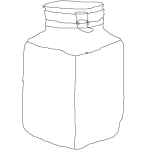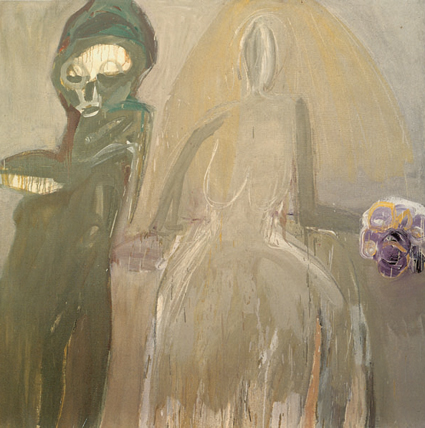When they fled Europe in 1939, Eva Hesse's family stayed briefly in the Upper East Side, in a building where now Fairway stocks imported olive oil and house roasted coffee beans, directly across from the headquarters of Fritz Kuhn's German American Bund. A photo from that October shows a parade streaming west on 86th Street toward Lexington Avenue. Hesse was 3 years old. If she had been watching from her window she would have seen 800 men marching in support of the Nazis, a Swastika flanked by a dozen or so American flags. As a child, Hesse said in an interview not long before she died of cancer at age 34, she would each night ask her father to recite a pair of promises. We will not be robbed. We will be here when you open your eyes.
Spectres, at the Brooklyn Museum of Art through January, comprises 19 oil paintings Eva Hesse completed in 1960, before she turned to sculpture. Among the most celebrated of the group is a painting of a bride, her muted purple bouquet, and a dark, hollow-eyed figure who seems to guide the bride to the edge of the canvas. The December afternoon I visit the exhibit, a docent suggests to her group that they consider the work a depiction of the passage to matrimony haunted by doubts.
Perhaps. But as I spend time with the painting, I think of a different passage. What if the translucent bride is Eurydice, setting off with Orpheus out of the underworld, and the anticipated moment, already written on Eurydice's featureless face, that when Orpheus will turn back to look at her? We know Orpheus' terror. Now for a moment we might glimpse Eurydice's. Arms and breasts frame her dress, but Eurydice is in some sense already gone. She is, as Derrida defines spectre, a "thing in flight that surpasses the senses." She is a bodiless body.
Coming to the Spectres paintings knowing Hesse's sculpture is initially to feel the poverty of material. Where is the rubber, fiberglass, mesh, or wire? The paintings line a narrow room. Not only are we unable to walk around a piece, to view it from a different angle, we are tightly constricted even in how far we can step from the image. Yet the connection to the work Hesse would go on to make is unmistakable. These blurry portraits are not fully realized figures. We catch them just before they are erased. If they meet our gaze, it is from a space we cannot occupy.
Hesse claimed she aimed to make "nothings." Think of her 1968 piece Repetition Nineteen III. Nineteen translucent industrial fiberglass cylinders, each about 19 inches tall and 11 to 12 ¾ inches in diameter, are arranged without set order on the floor. The forms are all the same shape, but none identical to another. Each obsessively suggests, but refuses to stand in for a body. They are hollow. They appear fragile. The cylinders are not symbols. Nor are they remnants. When I see them I think of the rawness of new grief, of obsessively seeking that which is lost, of again and again confronting that which is not quite the object grieved.
Hesse's work is often tactile. We want to hold the cylinder in Repetition to be sure it is more than a trick of light. Though we know it is not spirit, it does not seem to us to be thing. Rather, the cylinder is most like the medium through which the mourned might make its claim known. It is the haunting. This transitory state menaces the living and so, like Orpheus, we travel to the underworld not to rescue, but to bury. Only in the moment we turn our gaze, we find that the cylinder refuses to complete the passage. It will not change to ghost.
As I walk home from the exhibit I remember a recurring dream I had the weeks after my friend Eileen died. I am in Wellfleet, MA, where years earlier Eileen took my sister and me for summer vacation. There's been a storm and the power is down across the Cape. I don't have Eileen's ashes so I buy a maple cutting board from an antique shop around the corner to throw to the ocean. When I get to the shore, kids and lifeguards swarm the beach. Searching for a private spot, I follow a splintered boardwalk north. A few steps behind me, a little boy swings between his parents. I am preparing to send the cutting board to the sea when the dream shifts. Suddenly I am the board in a stranger's arms. What was once the little boy laughing is now indistinguishable from waves breaking. In the dream I panic. In recollection I tell myself, I will not be robbed. I will be here when my eyes open.


 contents
contents